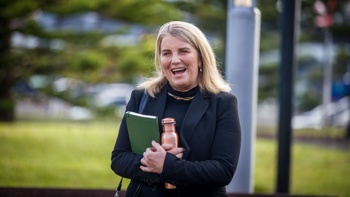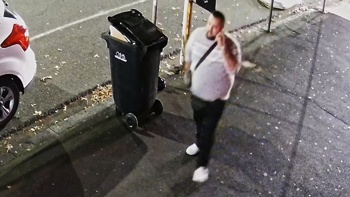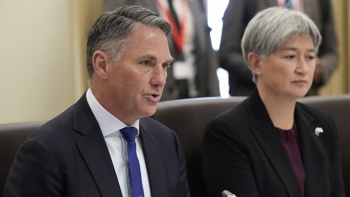Growing up in Pākehā-dominated Ōtautahi (Christchurch) made it difficult for Stacey Morrison to embrace her Māori side.
It was a trip to Japan and learning the language there that highlighted the "irony" of not speaking te reo.
Her husband Scotty, of Ngāti Whakaue descent, also didn't grow up with te reo in his Rotorua home, nor was it spoken in his wider family.
When he started teachers' training college, he took an introduction to te reo paper, and from there his passion grew, and being exposed to mentors like Sir Timoti Karetu and Wharehuia Milroy motivated him to take it even further.
The couple are at the forefront of the te reo revitalisation movement that is seeing thousands of adult Kiwis take up the kaupapa each year.
But they are more than aware of how fortunate their positions are.
"We are part of a generation that could have seen the language die," says Stacey, of Te Arawa and Ngai Tahu.
/arc-anglerfish-syd-prod-nzme.s3.amazonaws.com/public/HFVF2NSRAREITBA7ITX4LEZUBA.jpg)
The Morrisons have both written books in te reo. Photo / Dean Purcell.
"But instead, we have seen it become mainstream, and that is why every time we are asked to do an interview, Scotty and I will turn up, because those people before us ensured there was still something to talk about."
She and Scotty have written six books on te reo between them - including Māori at Home together - selling over a hundred thousand copies.
They see their public and influential lives as broadcasters – Scotty with Te Karere and Marae, Stacey on The Hits and various Māori TV shows – as carrying a responsibility to help with revitalising te reo.
Next week is Māori Language Week and as part of that, the NZ Herald's masthead - along with NZME's five other daily newspapers - will be published in te reo.
The Government has a target of having one million New Zealanders speaking basic te reo by 2040, which is a long way off the 2013 Census that shows just 148,400 New Zealanders can hold a basic conversation in te reo - 84.5 per cent of whom are Māori.
But according to the Tertiary Education Commission, those numbers might soon be turning around.
The number of people enrolled in Māori language courses at polytechnics, universities and wānanga has grown from just over 16,000 in 2014 to nearly 25,000 in 2018.
Those taking beginner – level 1 and 2 – classes has nearly doubled in that time, from 7134 to 12,835. The majority of the growth has only occurred in the past three years.
About 7000 of those adult students across the country are enrolled at Te Wānanga o Aotearoa, and chief executive Te Ururoa Flavell says despite being at capacity, demand is so high they can probably more than double that number.
/arc-anglerfish-syd-prod-nzme.s3.amazonaws.com/public/XUS6764NTJCYXOYJ44F5HOMQ74.jpg)
Te Wānanga o Aotearoa chief executive Te Ururoa Flavell says demand is outstripping supply for te reo courses across the country. Photo / File
For one of next year's courses in Hamilton there is already a waiting list of more than 150 people.
"Kiwis are signing up in their thousands each year, so we need to work constructively to ensure those who want to be learning languages have the access."
While the majority of their students are in beginner classes, about 30 to 40 per cent carry on to higher levels.
Flavell is encouraging of recent government efforts to increase the number of teachers, and online tools, and also wants to see a funding cap on students enrolling lifted.
Scotty and Stacey make a conscious effort to raise their three children bilingual, and speak only Māori at home.
That experience has influenced Stacey's latest book, My First Words in Te Reo.
"Babies' brains are very open to everything. It is a beautiful experience being able to offer them two languages. It might just be few words, but there are huge benefits of opening neural pathways."
While speaking Māori with her children in a supermarket a few years ago, Stacey was told by a fellow shopper to stop speaking "that jungle language".
But those experiences are balanced with many positive ones, and the negatives are becoming far fewer.
"There has been a massive dial shift over even just the past three to five years," says Scotty.
"There are still pockets of negativity, but the new generation really sees te reo as a key part of our identity, and recognise the benefits you only see once you begin learning."
Businesses make progress
Scotty has worked with many of New Zealand's major companies - including Spark and his own employer TVNZ - on developing strategies on reo and tikanga (protocol).
That work led to Māori at Work, which includes everything from handy phrases like "Me tiki kawhe tāua?/Would you like to grab a coffee?", but also chapters on tikanga - Māori processes and protocols - and even the Treaty of Waitangi.
"There are companies that go ad hoc, and make mistakes, but there is progress, and importantly more and more CEOs, so from the top, are getting on board with the kaupapa."
He and Stacey, who MCs corporate events, find companies increasingly appreciate Māori processes, from handling a death in the workplace, to performing mihi.
"When someone stands up and says, 'Nau mai, haere mai', it has a wairua - feeling - and adds something more meaningful, by using the language of the land," Stacey says.
Scotty dedicated his latest work to the late Te Wharehuia Milroy, a kaiako (teacher) and mentor of his, and who passed away earlier this year.
"Our duty is to build on that work, it is not a personal mission, but an intergenerational one.
"We need our people on the street with their placards, in corporate areas, in kohanga reo - we need our people everywhere, driving the normalisation of te reo, and our books are just a part of that."
/arc-anglerfish-syd-prod-nzme.s3.amazonaws.com/public/USLAFZ2ZMRHNHOAFQLD35KIRAE.jpg)
Auckland Council reo Māori specialist Nikora Wharerau with John McCaffery, who was involved in the Māori language petition in 1972 with Wharerau's father Waihoroi Shortland. Photo / Dean Purcell
At Spark, Māori strategy lead Lisa Paraku says all employees have opportunities to do various te reo and tikanga training.
The company has its own waiata, and mihi and pōwhiri are used at staff events.
It also produced the hugely popular app Kupu, which allows users to take a picture and have the object identified in Māori.
National carrier Air New Zealand has been developing its te reo strategy over about the past 10 years, cultural development manager Henare Johnson says.
"We started with introducing 'kia ora' to our customers, then 'mā te wā', and now we are filling in the middle."
Badges are worn to identify the company's 25 fluent staff, and they have a lofty ambition to increase that to 200 over the next five years, Johnson says.
They also have about 170 Māori ambassadors to help the company's 12,000 staff with language and cultural queries.
About half of those ambassadors were non-Māori, and half of them not born in New Zealand.
"A lot of what we do has really been staff-led," Johnson says.
"We assist with a bit of vocabulary and pronunciation, and everybody has just taken to it."
Public institutions are also getting on board.
/arc-anglerfish-syd-prod-nzme.s3.amazonaws.com/public/TL3SPIJFIZEEVJUXFNHFYETT7A.jpg)
Auckland Council reo Māori specialist Nikora Wharerau and John McCaffery, who was involved in the 1972 Māori language. Photo / Dean Purcell
In 2018, Wellington Council instituted its own te reo policy, Te Tauihu, to make the language more visible, and with a goal to become a "te reo capital" by 2040.
Auckland Council has also been promoting te reo among its staff, and Auckland Transport recently instituted announcements in te reo on its trains and buses.
On Thursday, Auckland Council, along with the city's 13 iwi and hapū, have put together a hīkoi on Maungakiekie/One Tree Hill, to celebrate Te Wiki o Te Reo Māori, and leaders of the 1972 petition.
Te Reo Māori Society co-founder John McCaffery, who will join several other leaders - including Te Rito - from the 1972 petition movement on the hīkoi, says the way businesses and institutions are getting behind te reo shows it has become "cool to kōrero".
"They wouldn't be doing it unless it was good for PR or their image," the language and linguistics researcher says.
Despite being Pākehā and growing up in New Zealand at a time when te reo was being actively discouraged, his parents - Irish migrants who had seen discrimination in their home country - encouraged him to learn.
McCaffery says it is important to remember the 1972 petition includes a line about te reo being a "gift to the Pākehā from the Māori in all other New Zealand schools as a positive effort to promote a more meaningful concept of integration".
Essentially, more Pākehā need to be learning, he says.
"It is part of who we are as a nation."
Are we doing enough for te reo to thrive?
But AUT history professor Dr Paul Moon does not believe enough is being done to save te reo.
He published a controversial book titled Killing Te Reo Māori last year, where he says while he wants te reo Māori to succeed, he fears the dominating power of English will "swamp" it.
"Being optimistic doesn't cut it anymore," he tells the Herald on Sunday.
"We don't just need more resources but a completely new way of approaching it."
Te Taura Whiri I Te Reo Māori (Māori Language Commission) chief executive Ngahiwi Apanui says while there are many positive things happening across the country, more needs to be done to reach the Government's 2040 goal.
As of July 2018, about 20 per cent of the total school population received no Māori language education, while about 56 per cent were learning simple words, greetings or songs.
Just 2.5 per cent of the country's schoolchildren were in Māori medium education (where over 50 per cent of tuition is in Māori) - a 0.1 per cent increase on 2017.
"Is that 2.5 per cent going to be enough to sustain the language?" Apanui says.
"To reach that government target I don't think we are doing enough. Māori has to be a core subject in schools."
/arc-anglerfish-syd-prod-nzme.s3.amazonaws.com/public/WE4JXHPLHVBZ3IHC7MRYGBJ7VI.jpg)
Associate Education Minister (Māori) Kelvin Davis. Photo / Stephen Parker
The question of making te reo Māori a core part of the curriculum has dominated discussions around te reo over the past several years.
So far only the Green Party has pushed the case politically, but outside the house they have support of teacher's union the New Zealand Education Institute/Te Riu Roa, and the Māori Language Commission.
Associate Education Minister (Māori) Kelvin Davis says while the demand for te reo is "fantastic" a lack of focus and funding for te reo-speaking teachers in the past has left a shortage, which his Government is trying to address.
In Budget 2018 he announced $12.2 million over four years to support Te Ahu o te Reo Māori to improve te reo capacity of teachers, with 685 people taking part this year.
Rather than compulsion, Davis says the Government is committed to integrating te reo Māori into education in early learning and schools by 2025.
"We've got the capacity issue with teachers and we also need to make sure we are bringing teachers along with us on this journey, in a non-threatening way."
How far have we come?
Dr Joe Te Rito "skipped" the generation of Māori who were beaten at school for speaking their mother tongue.
"That was my mother's generation – we just didn't have reo at school at all."
Luckily though, growing up in the 1950s in Mahia with his grandparents, it was still spoken at home.
That seed took him to Victoria University of Wellington in 1970, where he studied under Te Kapunga (Koro) Dewes, and fell right into the middle of a revitalisation movement that has continued to this day.
Amid fears the language was becoming endangered, Te Rito joined the university's Te Reo Society, which linked up with Auckland's Ngā Tamatoa in 1971 to gather signatures for a Māori language petition calling for te reo classes in schools.
On September 14, 1972, Te Rito was there as Ngā Tamatoa's Hana Jackson delivered the petition with over 30,000 signatures to the government.
/arc-anglerfish-syd-prod-nzme.s3.amazonaws.com/public/B4CUALOH25C7FANSG4EVAJRB44.jpg)
Dr Joe Te Rito's work with Te Reo Society and Ngā Tamatoa was the catalyst for Māori Language Day - extended to Māori Language Week in 1975. Photo / Paul Estcourt
Their work was the catalyst for that date becoming Māori Language Day – extended to Māori Language Week in 1975, an increase in Māori tuition across the country, and Māori becoming an official language in 1987, among other developments.
Despite similar conversations continuing today around te reo in schools and a lack of funding, Te Rito says as a country we have come a long way.
"Back then we got doors slammed in our faces, were spat at, told the language was useless, and it was not heard anywhere mainstream."
In 1971 the group had to pay the New Zealand Broadcasting Corporation $1 a word for it to be spoken on air as it was deemed advertising.
"Now there are Pākehā like Guyon Espiner and Jack Tame speaking it.
"The language is still in danger, we can't lose sight of that, but there is goodwill and enthusiasm at a level I have never seen before."
Take your Radio, Podcasts and Music with you









